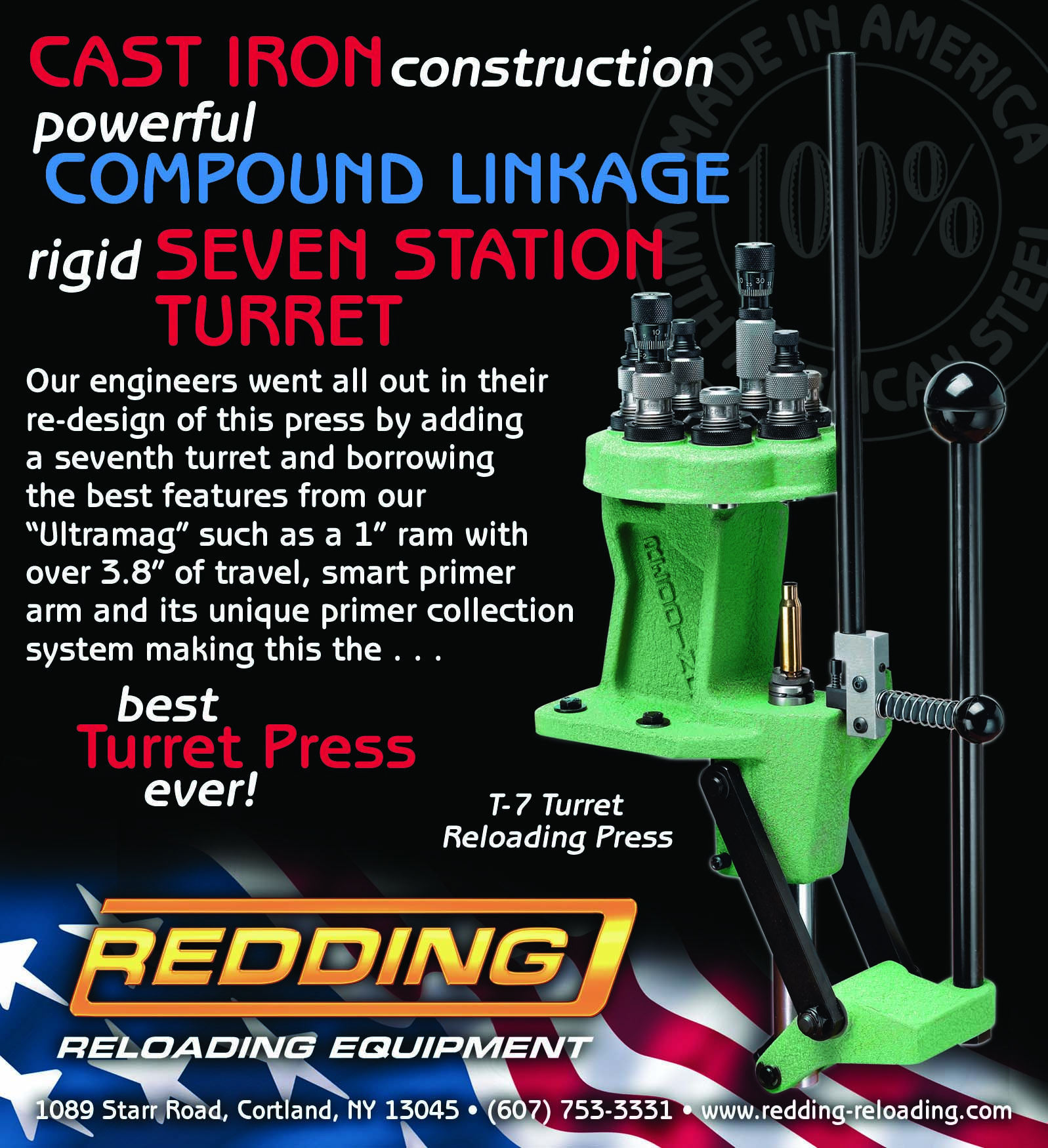by Art Merrill | Contributing Editor
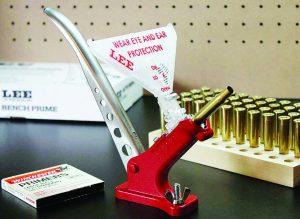
The Lee Auto Bench Prime has a ‘steampunk’ attractiveness.
Handloading at a single stage press is not about speed, it’s about quality, consistency and—most importantly for the beginner—attention to detail. Compared to progressive reloading presses, the single stage is a truck among Porsches. We also perform tasks at the single stage press that progressives ignore like a 918 Spyder passing a vegetable truck on the Interstate. We resize brass, measure it, trim it and measure it again. We chamfer inside and outside the case mouth, brush out the neck and clean the primer pocket. We weigh every powder charge. We individually seat every primer.
That doesn’t mean we want to be slow, it’s just that speed isn’t part of the equation that results in the best handloads, just like a Porsche isn’t going to carry many farmer’s cabbages to market. But if we could speed up the process without sacrificing quality…
Electricity significantly accelerates handloading without bypassing quality. Today I seat bullets or perform other tasks while my RCBS electronic powder dispenser/scale throws my preset charges at the push of a button—no more tedious trickling powder into a balance beam scale pan while waiting for gravity to catch up. My Gracey electric case trimmer can race through an entire Highpower season’s cases in one afternoon without turning a crank.
Now, while we await invention of the electric primer seater, let’s see what Lee Precision’s new Auto Bench Prime can do to speed up that particular process for us.
Nothing to lose
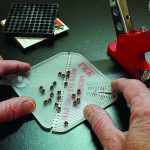
The primer reservoir doubles as a flip tray.
Figuring out the Auto Bench Prime is high on the No Frustration Factor List, and with the aid of the included photo instructions I was priming cases in less than ten minutes after opening the box. Form follows function, but that doesn’t mean tools have to be ugly; Lee’s bench primer has a pleasing kind of steampunk look to it, that combination of new tech and old design.
Materials appear to be cast aluminum, press formed heavy gauge aluminum, plastic and steel (the latter being screws). Construction is rather light compared to other bench mounted primers, which is fine because it discourages ham-handedness. Primers, after all, should seat properly without muscling them into place, which can distort, crush and possibly detonate them.
Unlike other primer seating tools that utilize itty-bitty parts to swap (and inevitably lose) when changing between large and small primers, the Lee tool features palm size plastic-and-steel primer adaptor assemblies that simply drop into the base unit. Each assembly separates into two halves held together with screws; if/when the assemblies ever need any internal attention, accessing will be simple.
The bright red base unit also separates into two halves with the removal of three screws, allowing easy user access for lubricating the lever pivots or debugging whatever problem might arise. We’ve all been frustrated by a balky or gummed-up moving-parts tool that we can’t easily get inside of to fix or clean; Lee’s use of screws instead of rivets or tack welds throughout the Auto Bench Prime is a big plus for DIY guys.
Of course, you’ll need to mount the tool to your bench; it will fit Lee’s Accessory Bench Plate—a handy accessory especially for space-challenged areas—but attaching it to a piece of wood to bolt or C-clamp to your bench works as well. Lee thoughtfully provides two flat head bolts for such “mobile mounting.”
Leaving rubber
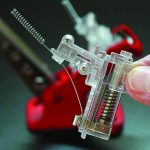
There’s no fumbling with tiny parts when changing primer seaters.
Lee says keeping the primer reservoir further away from the primer being seated reduces the possibility of a mass detonation, compared to other seaters. Another plus is our objective here: speed. There is no exhaustive preloading of individual primers in a tube. Instead, the reservoir opens to become a primer flipper tray; simply dump in a box of primers, shake them upright, snap it closed, insert into the base unit and start priming. Once establishing a rhythm, I was seating five to six primers per minute without even trying for speed.
That rhythm included tapping the lever at the top of its stroke in order to jostle the primers in the reservoir to prevent them hanging up and failing to feed. The “primer agitator spring” (the external spring on a wire in the adaptor photo) appears to be more about holding the reservoir firmly in place than about preventing primers from bridging the outlet.
In use, the seater exhibited a bit of balkiness at first. Tension from the primer adaptor holds the shell holder in place; on mine there wasn’t quite enough tension and the shell holder could rotate out of position when removing a case. On a scale of “Deal Killer” to “Ingenious Perfection,” that rates about “Mildly Annoying.”
More than just annoying, the connector link between the lever and the primer adaptor assembly tended to hang up inside the base unit and halt primer seating because, contrary to the enclosed instruction sheet, the “rubber up-stop” for the lever that also apparently doubled as a guide for the connector link has been deleted. An email exchange with Lee revealed the maker removed the up-stop because users weren’t bringing the lever fully against it on the upstroke, causing feeding failures. Lee packages the unit with a large rubber band tensioning the lever against the base; leaving that rubber band in place alleviated the balkiness. If that is the intent of the rubber band, the instruction sheet does not say so, and it is rather a Rube Goldberg fix for an otherwise clever device. Hopefully, Lee will address this problem and release a MK 1 MOD 0 version reaching “Ingenious Perfection.”
Printing on the box lid says you can use “any brand of primers,” but the instruction sheet cautions against using Federal brand Large size primers. Lee Precision tested their Auto Bench Prime by intentionally detonating several primer brands and types in the tool with the result that “…all types of Federal brand Large primers frequently caused the entire tray to explode with sufficient force to cause serious and painful injuries.”
The Auto Bench Prime requires the use of Lee’s own Hand Priming Tool Shell Holders—standard reloading press shell holders won’t fit. While that eliminates the irritation of moving shell holders from one tool to another, it also means that we can’t use those duplicate standard shell holders that we always seem to accumulate. C’est la vie.
MSRP for the Auto Bench Prime is $36.98. Add $20 for a set of 11 shell holders (60¢ each) and even toss in a couple extra $5 primer adaptor assemblies, and the total is still very reasonable, considering bench-mounted seaters from other makers are in the $100 range before buying the extras.
But if you’re patient and want to save a bit more money on a pre-owned Auto Bench Prime, I’ll give you a good deal on mine when that electric primer seater finally comes out.
Check that headstamp
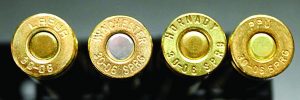
Commercial .30-06 with crimped primers. The crimping ring is most prominent on the Lapua and Hornady cases.
Cartridges intended for military use have primers secured by a crimp. The military deals in semiauto action and full auto machine guns, and the crimp prevents primers from possibly backing out of the case under recoil. A loose primer that falls into a firearm’s trigger group or action can render it inoperable.
Reloading military cases requires removal of the crimp; failure to do so will make primer seating more difficult— and possibly hazardous, as crushing a primer could detonate it. Our clue that something is amiss is when seating a primer in THIS cartridge case takes significantly more effort than the LAST one. Stop and investigate!
The case headstamp will indicate military brass. But commercial ammo can unexpectedly have crimped-in primers, too. Several companies make .30-06 specifically for use in the semiauto M1 Garand rifle, and so these specific cartridges have crimped-in primers. Among these, Creedmoor Sports utilizes Lapua brass and HSM uses Winchester. Hornady and Prvi Prtizan (PPU) have their own headstamps. When you see these headstamps on your .30-06 brass, look closer for the crimping ring in the brass around the primer.
We have a choice of tools available for swaging the crimp from primer pockets, and the subject is worthy of an article to itself. We’ll focus on removing primer crimps in the future.

